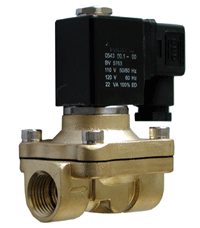|
Solenoid Valve Specifications and Dimensions: 2P160-250
and 2PO160-250Series
|
2P160-1/2 |
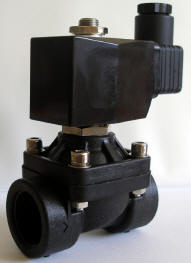 |
1/2" NPT |
1
=12VDC
2
=24VDC
2A
=24VAC
3
=110VAC
4
=220VAC
(50/60Hz) |
Cv=4.8
Orifice:16mm |
12-20W |
Service: Air, Liquid,
Oil, Water
Direct Lift Diaphragm
Normally Closed
Two Way Diaphragm
PA Plastic Solenoid Valve
Temperature:
32-122°F (0 TO 50 °C)
(with NBR Seal)
Pressure: Vacuum to 90 PSI
Vacuum Reverse Flow Direction |
 |
|
2P200-3/4 |
3/4" NPT |
Cv=7.6
Orifice:20mm |
|
2P250-1 |
1" NPT |
Cv=12
Orifice:25mm |
|
2PO160-1/2 |
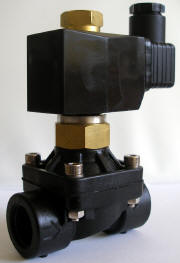 |
1/2" NPT |
1
=12VDC
2
=24VDC
2A
=24VAC
3
=110VAC
4
=220VAC
(50/60Hz) |
Cv=4.8
Orifice:16mm |
12-20W |
Service: Air, Liquid,
Oil, Water
Direct Lift Diaphragm
Normally Open
Two Way Diaphragm
PA Plastic Solenoid Valve
Temperature:
32-122°F (0 TO 50 °C)
(with NBR Seal)
Pressure: Vacuum to 90 PSI
Vacuum Reverse Flow Direction |
 |
|
2PO200-3/4 |
3/4" NPT |
Cv=7.6
Orifice:20mm |
|
2PO250-1 |
1" NPT |
Cv=12
Orifice:25mm |
|
Valve Model |
2P160-1/2 |
2P200-3/4 |
2P250-1 |
2PO160-1/2 |
2PO200-3/4 |
2PO250-1 |
|
Valve Type
|
2 Way Normally
Closed (NO) |
2 Way Normally
Open (NO) |
|
Action |
Direct
Lift Diaphragm |
|
Cv (Orifice) |
|
|
|
|
|
|
|
Operating
Pressure |
0 to 90 PSI |
|
Operating
Temperature |
32 to 122 °F
(0 TO 50
°C) |
|
Port Size (NPT) |
1/2 |
3/4 |
1 |
1/2 |
|
1 |
|
Body Materials |
Engineered Nylon Plastic |
|
Seal Materials
|
NBR |
|
Coil Protection
Insulation Class |
H Class IP65
|
|
Coil Duty
|
100% ED
|
|
Coil Power
|
20W |
|
Electrical
Connections |
DIN |
|
Service |
Air,
Liquid, Vacuum |
|
ALL Standard valves are supplied with CONTINUOUS DUTY COILS
of the proper class of insulation for the service indicated on the valve.
The coil temperature may become hot after being energized for extended
periods, but it is normal. Smoke or burning odor indicates excessive coil
temperature and should disconnect the power to the coil immediately.
VOLTAGES: Standard: 12-24V DC and 24-110-220-230V/50-60 Hz AC. Voltage
tolerances: +10% –5% for DC, +10%-15% for AC; .
SERVICE LIFE: The service life of the solenoid valve depends on the
operating conditions such as pressure, temperature, type of medium and the
voltage. |
|
Electrical Coil Connections |
|
For DIN Coil |
To connect DIN coil:
1. Remove the Philip screw from the plastic housing and unplug it from the
DIN coil.
2. From the screw opening, push the terminal block out from the plastic
housing.
3. Note the 1, 2 and ground markings on underside of DIN enclosure.
4. For DC DIN Coil, Connect 1 to Positive, 2 to Negative.
5. For AC DIN Coil, connect 1 to HOT wire, 2 to Neutral wire, and if
required connect ground to ground wire. |
|
For Grommet Coil |
To connect Grommet coil:
1. For DC Coil, connect one of the two wires to Positive, and the
other wire to Negative.
2. For AC Coil, connect one of the two wires to HOT wire, and the other wire
to neutral wire. |
|
CAUTION: Do not energize the
solenoid coil when it is not installed onto the valve. It may cause it to
overheat and create a fire hazard. |
|
2P
series 2/2 Direct Lift Diaphragm Normally Closed Solenoid Valve:
To open: when
the valve receives an electrical signal, a magnetic field is formed which
attracts the plunger covering the main orifice to lift off, causing system
pressure to drop. As system pressure on the top of the diaphragm is reduced,
full system pressure on the other side of the diaphragm acts to lift the
diaphragm away from the main orifice, which allows media to flow through the
valve. Since the bleed orifice is dimensionally smaller than the pilot
orifice, the system pressure cannot rebuild on the top of the diaphragm as
long as the pilot orifice remains open. When the system pressure is 0 PSI,
the valve also can be operated.
To close: when the valve
is de-energized, it releases its hold on the plunger. Then the plunger
forced by the spring drops and covers the main orifice. The system pressure
builds up on the top of the diaphragm through the bleed orifice, forcing the
diaphragm down until it covers the main orifice and stops media flow through
the valve. When the system pressure is 0 PSI, the valve still can be
operated.
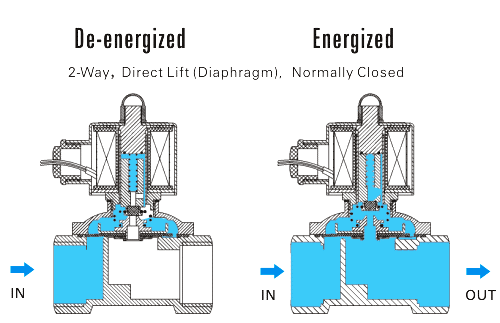 
|
|
2P Series
2/2 Direct Lift Diaphragm Normally Open Solenoid Valve:
To close: when the valve is energized, it
attracts the plunger. Then the plunger covers the main orifice. The system
pressure builds up on the top of the diaphragm/piston through the bleed
orifice, forcing the diaphragm/piston down until it covers the main orifice
and stops media flow through the valve. When the system pressure is 0 PSI,
the valve also can be operated.
To open: when the valve is de-energized, it releases its hold on the
plunger. The plunger uncovers the pilot orifice causing system pressure
holding the diaphragm/piston closed to drop. As system pressure on the top
of the diaphragm/piston is reduced, full system pressure on the opposite
side of the diaphragm/piston acts to lift the diaphragm/piston away from the
main orifice, which allows the full media flow through the valve. When the
system pressure is 0 PSI, the valve also can be operated.
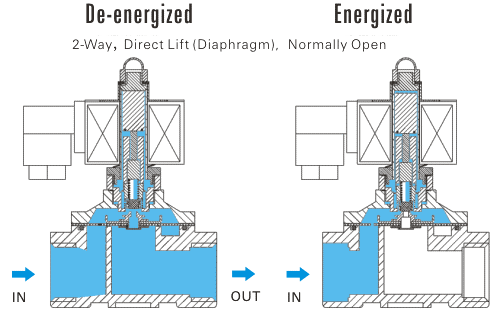
 |
|
MODEL: 2P160-250/2PO160-250 VALVE DIMENSIONS (MM) |
|
Model |
Port (NPT) |
Cv |
Orifice |
A
(2P Series Normally closed) |
A
(2PO Series Normally open) |
B |
C
(2P Series Normally closed) |
C
(2PO Series Normally open) |
D |
E |
F |
W (lb) |
|
2P160-1/2 |
1/2" |
4.8 |
16 |
100 |
113 |
51 |
115 |
128 |
74 |
36 |
60 |
1 |
|
2P200-3/4 |
3/4" |
7.6 |
20 |
95 |
108 |
51 |
115 |
128 |
70 |
36 |
60 |
1 |
|
2P250-1 |
1" |
12 |
25 |
105 |
118 |
65 |
125 |
138 |
87 |
36 |
60 |
1.2 |
|
|
 
|
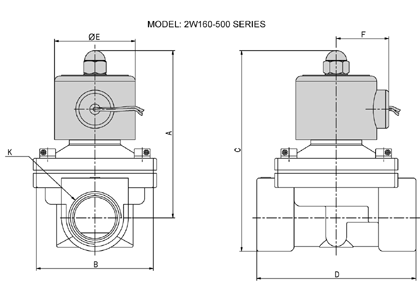 |
|





